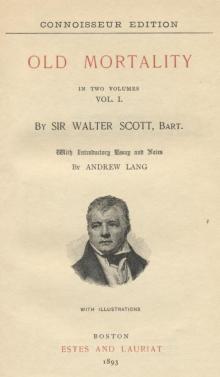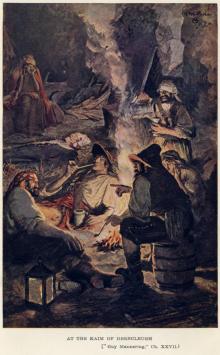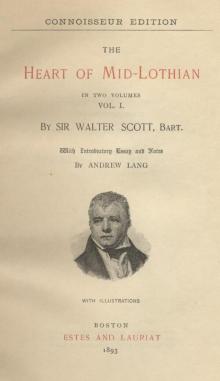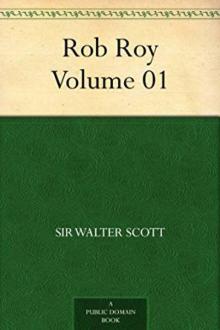- Home
- Walter Scott
Ivanhoe (Barnes & Noble Classics Series) Page 2
Ivanhoe (Barnes & Noble Classics Series) Read online
Page 2
1818 Scott receives a baronetcy. Mary Shelley’s Frankenstein is published. The Heart of Midlothian (the second Tales of My Landlord novel) is published.
1819 The third Tales of My Landlord series, comprising The Bride of Lammermoor and A Legend of Montrose, is published. Ivanhoe is published under the pseudonym Laurence Templeton and sells a remarkable 10,000 copies in two weeks; it is the first of Scott’s novels to take place outside Scotland. In Manchester, England, people who gather to protest economic conditions are attacked by soldiers in the Peterloo Massacre. Scott’s mother dies. George Gordon, Lord Byron’s Don Juan is published. John Keats’s “Ode to a Nightingale” is published.
1820 The Monastery and The Abbot are published. George III dies and is succeeded by George IV. Scott is elected president of the Royal Society of Edinburgh, and Oxford and Cambridge Universities award him honorary doctorates.
Ivanhoe continues to be a huge success. Percy Bysshe Shelley’s Prometheus Unbound is published.
1821 The Pirate is published.
1822 Kenilworth and The Fortunes of Nigel are published. As Edinburgh’s most celebrated resident, Scott welcomes King George IV when he visits the city.
1823 Quentin Durward, Peveril of the Peak, and St. Ronan’s Well are published.
1824 Redgauntlet is published.
1825 Tales of the Crusaders, including The Betrothed and The Talisman , is published. Around this time, Scott begins his Journal.
1826 As a major depression grips the country, Scott faces financial ruin when the companies of his publisher and printer collapse. Scott works for the rest of his life to pay off the debt incurred by the disaster. His wife, Charlotte, dies. Woodstock is published.
1827 Life of Napoleon Buonaparte and Chronicles of the Cannongate are published. Scott finally admits to the authorship of the Waverley novels.
1828 The Fair Maid of Perth is published. Scott begins compiling materials for an annotated edition of the Waverley novels.
1829 Anne of Geierstein is published. The first volumes of the annotated “Magnum Opus” edition of the novels appear. Scott suffers several hemorrhages as his health steadily worsens.
1830 George IV dies and is succeeded by William IV. In France, the July Revolution leads to the deposition of Charles X and the accession of Louis-Philippe I.
1831 Scott has a paralytic stroke. He travels to the Mediterranean to convalesce.
1832 The fourth Tales of My Landlord series, comprising Count Robert of Paris and Castle Dangerous, is published. Scott dies at Abbotsford on September 21. He is buried beside his wife at Dryburgh Abbey.
Introduction
From the beginning, Ivanhoe was distinguished by its huge readership and cult appeal. It sold 10,000 copies in its first two weeks, an unheard-of rate in 1819. That same year, a stage version opened in New York, and later Rossini composed Ivanhoe, the opera. Walter Scott had begun his literary career two decades earlier as a collector of Scottish ballads. He then turned his hand to poetry, specializing in grand romantic vistas and heroic themes from Scottish history. “The Lady of the Lake” (1810) made his name and fortune (which he later lost). But then along came Lord Byron. Almost overnight, Childe Harold’s Pilgrimage made Scott’s narrative poetry seem provincial and old hat. Making a virtue of necessity, Scott turned to fiction, with spectacular results. Waverley (1814), which looked back to Bonnie Prince Charlie’s Scots rebellion of 1745, was something altogether new to the British reader: the recreation of an entire historical canvas, populated by romantic but credible characters, acting out Britain’s painful emergence from its tribal past into modernity and nationhood. Variations on these themes inspired a further sequence of highly successful “Scottish” novels until in 1819, the ever-restless Scott felt the Caledonian well had run dry, and he ventured a new tale removed in both time and place: the England of the Middle Ages. The result was a book that can lay claim to being the most widely read novel of the nineteenth century, and among the most popular of all time.
Ivanhoe maintains a strong readership today, when the rest of Scott’s extraordinary literary output has sunk into obscurity, but it has never been a great critical success. The Scott purists wish he had never traveled south to England at all, and his compatriot David Daiches typifies the twentieth-century scholarly opinion of the novel: “Ivanhoe, though it has qualities of its own, is much more superficial than any of the Scottish novels, and is written throughout on a much lower plane. Scott did not, in fact, know the Middle Ages well and he had little understanding of its social or religious life” (“Scott’s Achievement as a Novelist,” p. 46; see “For Further Reading”). Since the 1980s, critics have turned back to Ivanhoe as an important thesis on British nationalism, and for its racial and sexual themes, but whatever the vicissitudes of its reputation among literary scholars, the novel always has enjoyed a cultural afterlife that much exceeded its scope and pretensions as literature. Ivanhoe single-handedly revived the age of chivalry in the Western popular imagination, and produced a cult of medieval rites and manners that persists into our own age, with its “Dungeons and Dragons” and Lord of the Rings. As for its cultural politics, the impact of Ivanhoe has been felt most deeply and controversially not in Britain, but in the United States.
“I lie here dying, slowly dying, under the blight of Sir Walter,” wrote Mark Twain to a friend in 1903 (Letters, p. 738). Scott loomed large for Twain the writer, who lamented the impact of his “wordy, windy, flowery ‘eloquence’” on American literature. But far more serious for Twain was the enduring cultural impression made by Scott’s Ivanhoe on the American South. The antebellum South was an essentially feudal system of rank and caste, and its white ruling class found in Scott’s romantic tale of chivalrous knights, powerful land-owning barons, and loyal serfs a glorious mirror image of itself. For Twain, whatever impetus toward modernization had existed toward “liberty, humanity, and progress” in the South was effectively smothered by the popularity of Scott, whose novels “set the world in love with dreams and phantoms; with decayed and swinish forms of religion; with decayed and degraded systems of government; with the sillinesses and emptinesses, sham grandeurs, sham gauds, and sham chivalries of a brainless and worthless long-vanished society.” The Scott “disease,” he went so far as to say, had caused the Civil War (Mississippi Writings, pp. 500-501). Ivanhoe became, arguably, even more necessary to the South after that war was lost. Scott’s title character spends much of the novel in disguise, and achieves his greatest triumph in the character of “The Disinherited Knight.” He is named for his estate—he is Wilfred of Ivanhoe—but does not or cannot claim it. Ivanhoe the place is never visited and barely mentioned, as if forgotten. The novel’s title thus points to a glaring absence in the world of the novel, both spiritual and material. England has been conquered, and the spoils have gone to the victorious Normans. As his chivalric pseudonym suggests, Ivanhoe the man is a complex figure representing both inherited nobility and loss, a romantic composite uniquely designed to appeal to the defeated Confederate sensibility.
If Ivanhoe’s fall from land-owning scion to homeless errant knight elicited a fragrant bitterness for the southern reader, no less intoxicating was the situation of his heart, torn between the blond, blue-eyed Saxon princess, Rowena, and the exotic Jew, Rebecca. It is one of literature’s most intriguing love triangles. Much controversy surrounds Scott’s representation of Jews in Ivanhoe, but one suggestive means of understanding the intense and destabilizing desires Rebecca inspires is as a figure for the white man’s attraction for and resistance to the prospect of racial mixture. This is certainly how the late-nineteenth-century African-American novelist Charles Chesnutt interpreted Ivanhoe’s dilemma. For Chesnutt, Scott was “the literary idol of the South,” and Chesnutt’s novel, The House Behind the Cedars (1900), contains a fascinating revision of one of Ivanhoe’s central episodes, the tournament at Ashby where the victorious Ivanhoe awards the crown to the fair Rowena. In Chesnutt’s novel, the Queen of Love and Beauty is als
o named Rowena, but she is dark: In fact, she is a mulatta passing for white. As another character later remarks, “She should have been named Rebecca instead of Rowena” (p. 92). In Chesnutt’s novel, Rowena’s rival is not a person, but a racial “other” incorporated within the romantic heroine herself. Ivanhoe’s romantic triangle is dissolved into an image of racial ambiguity, a mirror of his own ambivalence. Unsurprisingly, Chesnutt’s “black” Rowena dies in tragic circumstances. In Scott’s novel, the hero begins as a figure for cultural crossing—he has left his Saxon household to follow the Norman king—but the question of whether he is capable of making a second crossing, this time into an ostracized racial group, hangs over the novel until the very end. On the last page, describing Ivanhoe’s marriage to Rowena, Scott refuses to inquire “whether the recollection of Rebecca’s beauty and magnanimity did not recur to his mind more frequently than the fair descendant of Alfred might altogether have approved.” If Scott is reluctant, generations of readers have not been so coy. It is a cliché of Ivanhoe’s reception that the reader will inevitably wish the hero to have chosen the dark and inspiring Rebecca over her bland, blond rival.
As Chesnutt’s revisionary novel makes clear, Ivanhoe, fairly or not, has been put to use as a racist text. The American historical novelist Thomas Dixon based his reconstruction trilogy on a white supremacist reading of Ivanhoe—beginningwith A Leopard’s Spots (1902). Likewise, the Ku Klux Klan’s very name echoes the romantic “clans” of Scott’s fiction. The concluding chapters of Ivanhoe, which focus on the rituals of the Templar Knights, are especially haunting for the American reader. A secretive order of Christian militant men, dressed in white, take a dark-complexioned woman as prisoner, then conduct an extra-legal show trial at which she is condemned to burn at the stake. Rebecca is, of course, a Jew, and is saved at the last, so Scott could not have known in writing Ivanhoe that he was producing the iconography—the hooded white garb, the Masonic rituals, the burning cross—for the vilest and most feared racist organization in modern America.
But the Klan were poor readers of Ivanhoe. The reason that the inevitable marriage that concludes Scott’s romance has often seemed less than satisfying to readers is that it takes place outside the erotic space of the novel. As the union of two Saxons, Ivanhoe’s marrying Rowena is anomalous to the novel’s deep investment in the mixture of races, cultures, and languages. Scott’s assertion that the marriage marked a “pledge of the future peace and harmony betwixt two races” (p. 461) makes no sense, biologically or symbolically, since Ivanhoe and Rowena belong to the same race and are, in most respects, undifferentiated. Ironically, the greatest proponents of racial purity in the novel are not the Templar Knights or the Norman rulers but Ivanhoe’s father, Cedric, who takes a eugenic approach to the cause of Saxon restoration. He enforces his ideological commitment to Saxon purity even at the expense of his own son, whom he doesn’t consider sufficiently well born for Rowena. That said, Cedric’s nationalism is as much about policing English sexuality as it is about race. He blames the decline of Saxon culture on the Circe-like enchantment of “Norman arts”: “We became enervated by Norman arts long ere we fell under Norman arms. Far better was our homely diet, eaten in peace and liberty, than the luxurious dainties, the love of which hath delivered us as bondsmen to the foreign conqueror!” (p. 211). The Saxon way of life, Cedric argues, was not lost on the battlefield, but at the dinner table and in the dressing room, where Norman “luxury” imported its tantalizing customs and emasculated its fighting men. During the almost century-long sequence of wars against France that had just concluded when Scott wrote Ivanhoe, modern British masculinity was essentially constructed in opposition to perceived French “effeminacy.” His readers would thus have been well aware of “luxury” as a code-word for degraded French manhood, and taken delight in his sardonic descriptions of the “fripperies” of Norman dress.
Scott’s fascination with mixture extends to all aspects of the novel, including language. There is no better image of the “multiculturalism” of early Norman England, as conceived by Scott, than Ivanhoe and Richard’s horrified reaction to Athelstane’s animated appearance at his own funeral: “Ivanhoe crossed himself, repeating prayers in Saxon, Latin, or Norman-French, as they occurred to his memory, while Richard alternately said, Benedicte, and swore, Mort de ma vie!’ (p. 436). Spanish, Arabic, and Hebrew are likewise spoken in the novel. The master language of Ivanhoe itself, modern English, is a product of this historical moment, a ”mixed language” in which the linguistic distinctions between Saxon and Norman have ”disappeared” along with the deep cultural antagonisms in the aftermath of the Conquest. That the many languages and cultures should be ”completely mingled” is the endpoint of Ivanhoe’s historical trajectory, and the book travels back to a time when this amalgamation was as yet unachieved. Its heroes therefore are those who intuit and obey the imperative to cross over from their ”home” culture to a new order. What Cedric sees in his son as an act of betrayal, the reader perceives as a necessary, if perhaps over-enthusiastic embrace of the new post-Conquest order. But if Ivanhoe embarks on the exemplary crossing of the novel, from Saxon to Norman, it is far from the most imaginative or interesting. That distinction belongs to the illicit, cross-cultural desires of Rebecca for Ivanhoe and, most spectacularly, the Templar Knight Bois-Guilbert’s reckless passion for Rebecca.
Bois-Guilbert’s emotional signature is vacillation—“a man agitated by strong and contending passions” (p. 403)—but he never gives up his desire for Rebecca, and literally dies of her rejection. We admire Rebecca for her choice of religion (and celibacy) over her love for Ivanhoe, but Bois-Guilbert thrills us with his readiness to take the Jewess at any odds, giving up fame, religion, honor, and everything that has heretofore constituted his heroic, chivalric identity. He talks to her of returning to Palestine, to install her as queen of some new, supra-national Masonic order. Rebecca calls it a “dream ... an empty vision of the night” (p. 399), and she is probably right. But Bois-Guilbert is the only character capable of such imagining, and he is willing to make the most scandalous crossing of all, from Templar Christian Knight to Jew. In looking so far beyond the cultural boundaries of twelfth-century Europe, it is Bois-Guilbert who most belongs to Scott’s own global, post-enlightenment moment. “England—Europe—is not the world” (p. 398), he tells Rebecca. He calls conventional religion “nursery tales” and “bigotry” and instead makes a religion of himself and his own will, like a character in Byron or Dostoevsky. He is not a man of his age, and by the end his fellow knights cannot even look at him: “His general appearance was grand and commanding; but, looking at him with attention, men read that in his dark features, from which they willingly withdrew their eyes” (p. 447). Note Scott’s odd turn of phrase: not repulsion, but a “willing” withdrawal of the eyes. The knights refuse to “read” the futurity in Bois-Guilbert’s face, mistaking it for darkness. As with Milton’s Satan in Paradise Lost, villainy is not incompatible with lyricism in Ivanhoe. Bois-Guilbert might despise religion, but it is to him that Scott gives the most poetic theological reflection in the novel, when he speaks to Rebecca of the transfigurations of the body at death, “dispersed to the elements of which our strange forms are so mystically composed—not a relic left of that graceful frame, from which we could say this lived and moved!” (p. 399). Rebecca’s stoic faith has grandeur, but not such depths as Bois-Guilbert’s despair. The fact that he dies not from Ivanhoe’s lance but his own “contending passions” is a fantastic, even surreal moment in the text that has embarrassed and perplexed Scott’s readers, but in fact manifests beautifully the historical impossibility of the Templar Knight’s continuing presence in the book. It would do as well for him to have disappeared in a puff of smoke, and awakened on the streets of St. Petersburg in 1895, or Paris in 1968.
As an object of desire in the novel who chooses exile over those who might love her, Rebecca resembles no one in the novel more strikingly than King Richard, who is likewise the obje
ct of Ivanhoe’s (and England’s) frustrated love. Richard tantalizingly comes within the precincts of his kingdom, but remotely, in disguise. And when he reveals himself, it is only a temporary emergence from his preferred elusive career as a knight errant. Although the novel ends at a moment of promise for Richard’s reign, Scott has already informed us that he will fail as king, and die on some foolish military adventure in Belgium. Rebecca might belong to an ostracized community, and Richard be merely “brilliant, but useless” (p. 424), but in terms of the generative energies of the novel itself, they are equals. Their remoteness, their unavailability, governs it all. Only Richard’s neglect has allowed the political ambitions of his brother John, and the resistant romantic nationalism of the Saxon Cedric, to flourish. Only Richard’s failure in Palestine has brought Ivanhoe home at all. And it is Rebecca who produces the final showdown between Ivanhoe and Bois-Guilbert, the former ready to desert Rowena even at the very moment of their betrothal. In riding, half-dead, to Templestowe to rescue Rebecca, Ivanhoe shows us that the impediments to his union with Rowena have never been important. It is the impossible union with Rebecca that drives him, and with it the real action of the novel.
But Rebecca, like Richard, is a love object who will not be loved, an exile who will soon return to exile. Thus the central love objects of the novel are never properly integrated into the national community, leaving the prospects for the emergent Anglo-Norman civilization meager and almost uninteresting. Without Christian chivalry and its magnificent opposite, Jewish martyrdom, Scott’s England is left in a muddle, and it is no wonder that he does not extend the novel to describe its bleak return to what Rebecca calls “a land of war and blood, surrounded by hostile neighbours, and distracted by internal factions” (p. 462). This is the pessimistic counterpoint to the progressive theme of cultural mixture in the novel, and one that seems particularly relevant to the time of Scott’s writing, when Britain’s devastating war against Napoleon had only just concluded, and citizens protesting for political reform lay dead in the town squares of the north at the hands of their countrymen.

 Ivanhoe: A Romance
Ivanhoe: A Romance Old Mortality, Complete
Old Mortality, Complete The Pirate
The Pirate Kenilworth
Kenilworth The Black Dwarf
The Black Dwarf A Legend of Montrose
A Legend of Montrose The Monastery
The Monastery The Bride of Lammermoor
The Bride of Lammermoor Redgauntlet: A Tale Of The Eighteenth Century
Redgauntlet: A Tale Of The Eighteenth Century St. Ronan's Well
St. Ronan's Well The Fair Maid of Perth; Or, St. Valentine's Day
The Fair Maid of Perth; Or, St. Valentine's Day Woodstock; or, the Cavalier
Woodstock; or, the Cavalier_preview.jpg) Anne of Geierstein; Or, The Maiden of the Mist. Volume 1 (of 2)
Anne of Geierstein; Or, The Maiden of the Mist. Volume 1 (of 2) Peveril of the Peak
Peveril of the Peak Waverley; Or, 'Tis Sixty Years Since
Waverley; Or, 'Tis Sixty Years Since Old Mortality, Volume 1.
Old Mortality, Volume 1. Waverley Novels — Volume 12
Waverley Novels — Volume 12 The Heart of Mid-Lothian, Complete
The Heart of Mid-Lothian, Complete Quentin Durward
Quentin Durward Waverley; Or 'Tis Sixty Years Since — Complete
Waverley; Or 'Tis Sixty Years Since — Complete Guy Mannering; or, The Astrologer — Complete
Guy Mannering; or, The Astrologer — Complete Rob Roy — Complete
Rob Roy — Complete The Heart of Mid-Lothian, Volume 2
The Heart of Mid-Lothian, Volume 2 Guy Mannering, Or, the Astrologer — Complete
Guy Mannering, Or, the Astrologer — Complete_preview.jpg) Anne of Geierstein; Or, The Maiden of the Mist. Volume 2 (of 2)
Anne of Geierstein; Or, The Maiden of the Mist. Volume 2 (of 2) The Heart of Mid-Lothian, Volume 1
The Heart of Mid-Lothian, Volume 1 Rob Roy — Volume 01
Rob Roy — Volume 01 Waverley; Or, 'Tis Sixty Years Since — Volume 2
Waverley; Or, 'Tis Sixty Years Since — Volume 2 Waverley; Or, 'Tis Sixty Years Since — Volume 1
Waverley; Or, 'Tis Sixty Years Since — Volume 1 Guy Mannering, Or, the Astrologer — Volume 01
Guy Mannering, Or, the Astrologer — Volume 01 The Talisman toc-2
The Talisman toc-2 Rob Roy
Rob Roy Old Mortality, Volume 2.
Old Mortality, Volume 2. The Betrothed
The Betrothed Waverley
Waverley The Surgeon's Daughter
The Surgeon's Daughter Ivanhoe (Barnes & Noble Classics Series)
Ivanhoe (Barnes & Noble Classics Series) The Antiquary
The Antiquary Letters on Demonology and Witchcraft
Letters on Demonology and Witchcraft Trial of Duncan Terig
Trial of Duncan Terig Redgauntlet
Redgauntlet My Aunt Margaret's Mirror
My Aunt Margaret's Mirror Guy Mannering or The Astrologer
Guy Mannering or The Astrologer Marmion
Marmion The Tapestried Chamber, and Death of the Laird's Jock
The Tapestried Chamber, and Death of the Laird's Jock Chronicles of the Canongate
Chronicles of the Canongate The Fair Maid of Perth or St. Valentine's Day
The Fair Maid of Perth or St. Valentine's Day The Heart of Mid-Lothian
The Heart of Mid-Lothian Lady of the Lake
Lady of the Lake